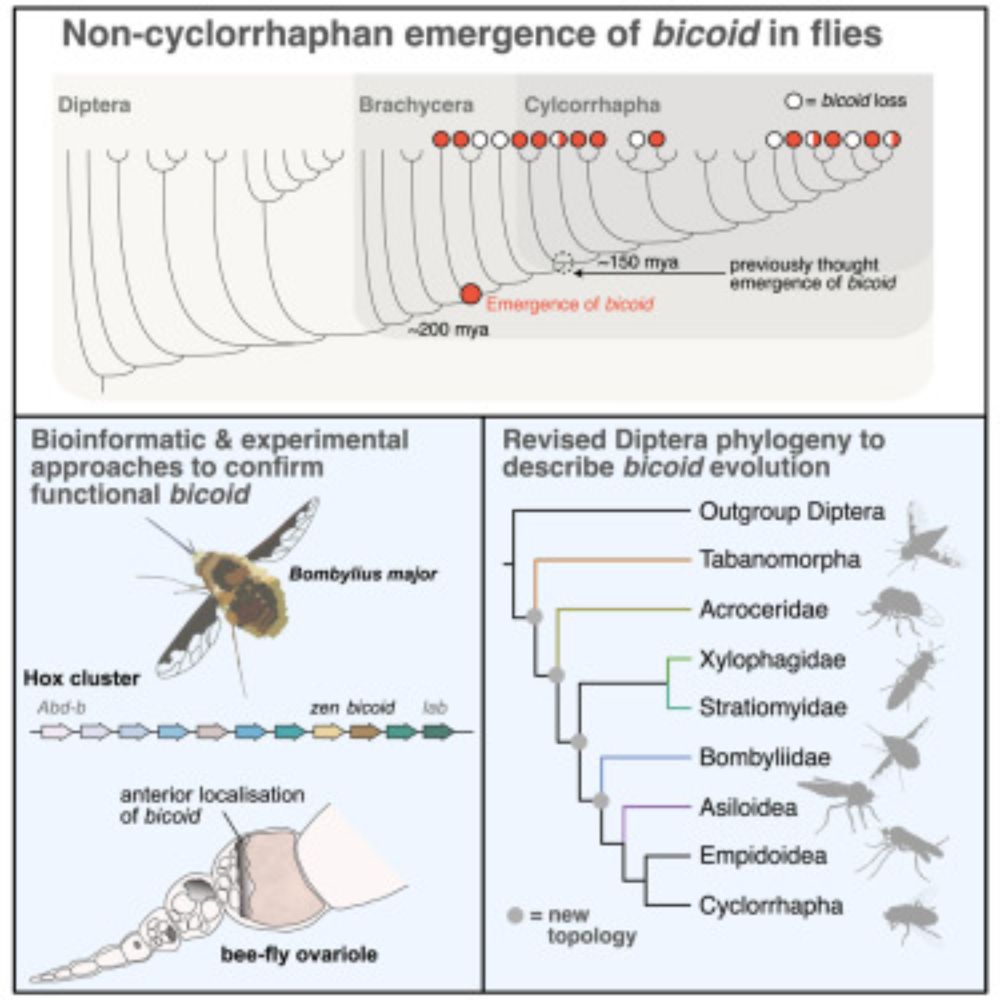
piRNAs | paralogs | epigenetics | transposons | flies
Group leader, Aarhus University, Denmark (https://mbg.au.dk/pan)
YOLO but germ cells are immortal and I wanna know how they do that.

1/ Genome defence pathway genes are crucial for animal fertility yet often evolve rapidly. We investigated the molecular basis of such rapid evolution in the fly piRNA pathway
TL;DR: protein-protein interaction innovation 💡🤝
🧵👇
www.biorxiv.org/content/10.1...
www.nature.com/articles/s41...

www.nature.com/articles/s41...
We find the fly development gene bicoid is much older than previously thought (~20 million yrs older!) 🪰🧬
To pinpoint its origins we tackled the Diptera phylogeny, providing some resolution (many open questions remain).
🔗 tinyurl.com/2vyuevpy

We find the fly development gene bicoid is much older than previously thought (~20 million yrs older!) 🪰🧬
To pinpoint its origins we tackled the Diptera phylogeny, providing some resolution (many open questions remain).
🔗 tinyurl.com/2vyuevpy
www.au.dk/om/stillinge...

www.au.dk/om/stillinge...
I am very excited to finally share what has been the main focus of my PhD for the past almost 3 years! It is about viral dark matter and a powerful tool we built to shed light on it. 🧬💡
Continue reading (🧵)

I am very excited to finally share what has been the main focus of my PhD for the past almost 3 years! It is about viral dark matter and a powerful tool we built to shed light on it. 🧬💡
Continue reading (🧵)
Thanks for reading! 20/20
Thanks for reading! 20/20


𝐓𝐡𝐞 𝐠𝐞𝐧𝐮𝐬 𝐂𝐡𝐲𝐦𝐨𝐦𝐲𝐳𝐚 𝐢𝐬 𝐩𝐚𝐫𝐚𝐩𝐡𝐲𝐥𝐞𝐭𝐢𝐜!
#Phylogeny #TreeOfLife #Drosophila #Diptera
(… 𝘐 𝘤𝘰𝘮𝘱𝘭𝘦𝘵𝘦𝘭𝘺 𝘮𝘢𝘥𝘦 𝘵𝘩𝘢𝘵 𝘶𝘱 𝘫𝘶𝘴𝘵 𝘵𝘰 𝘨𝘦𝘵 𝘺𝘰𝘶𝘳 𝘢𝘵𝘵𝘦𝘯𝘵𝘪𝘰𝘯, 𝘱𝘭𝘦𝘢𝘴𝘦 𝘭𝘰𝘰𝘬 𝘢𝘵 𝘮𝘺 𝘲𝘶𝘦𝘴𝘵𝘪𝘰𝘯 𝘣𝘦𝘭𝘰𝘸)
#Evolution #Phylogeny

𝐓𝐡𝐞 𝐠𝐞𝐧𝐮𝐬 𝐂𝐡𝐲𝐦𝐨𝐦𝐲𝐳𝐚 𝐢𝐬 𝐩𝐚𝐫𝐚𝐩𝐡𝐲𝐥𝐞𝐭𝐢𝐜!
#Phylogeny #TreeOfLife #Drosophila #Diptera
(… 𝘐 𝘤𝘰𝘮𝘱𝘭𝘦𝘵𝘦𝘭𝘺 𝘮𝘢𝘥𝘦 𝘵𝘩𝘢𝘵 𝘶𝘱 𝘫𝘶𝘴𝘵 𝘵𝘰 𝘨𝘦𝘵 𝘺𝘰𝘶𝘳 𝘢𝘵𝘵𝘦𝘯𝘵𝘪𝘰𝘯, 𝘱𝘭𝘦𝘢𝘴𝘦 𝘭𝘰𝘰𝘬 𝘢𝘵 𝘮𝘺 𝘲𝘶𝘦𝘴𝘵𝘪𝘰𝘯 𝘣𝘦𝘭𝘰𝘸)

(Please repost to reach a broad audience.)
(Please repost to reach a broad audience.)


Here, we combine the PacBio Iso-Seq workflow with the established WhatsHap phasing approach to assign long reads to the correct allele in polymorphic F1 mouse hybrids.
Here, we combine the PacBio Iso-Seq workflow with the established WhatsHap phasing approach to assign long reads to the correct allele in polymorphic F1 mouse hybrids.
rdcu.be/eOc0q

rdcu.be/eOc0q
A collaborative effort spanning many years and several labs to uncover what the germline chromosomes of Paramecium really look like. 🔗 www.biorxiv.org/content/10.1...
1/5

A collaborative effort spanning many years and several labs to uncover what the germline chromosomes of Paramecium really look like. 🔗 www.biorxiv.org/content/10.1...
1/5
How the stables have turned.
How the stables have turned.

this meeting is a good reflection of the excitement and collegiality in the transposon field.
kindly sponsored by @embo.org
The opening remarks by Julius Brennecke accompanied by his fellow scientific organisers:
🔹Déborah Bourc'his
🔹Josefa González
🔹Joseph Peters
#EMBOMobileGenome

this meeting is a good reflection of the excitement and collegiality in the transposon field.
kindly sponsored by @embo.org
Updating a lecture made me start from scratch to make it... ✨ ultimate ✨
Main focus: anti-viral and genome defense functions in plants+fungi+invertebrates
If you have input (or even better *slides*), please reply here or DM me
Thanks!
Updating a lecture made me start from scratch to make it... ✨ ultimate ✨
Main focus: anti-viral and genome defense functions in plants+fungi+invertebrates
If you have input (or even better *slides*), please reply here or DM me
Thanks!

We show that #Expansion #Microscopy is a broad-spectrum modality for Euks, enabling 3D phenotypic maps rooted to phylogeny.
#ProtistsOnSky #SciComm #SciSky
www.cell.com/cell/fulltex...
We show that #Expansion #Microscopy is a broad-spectrum modality for Euks, enabling 3D phenotypic maps rooted to phylogeny.
#ProtistsOnSky #SciComm #SciSky
www.cell.com/cell/fulltex...

